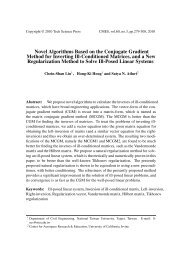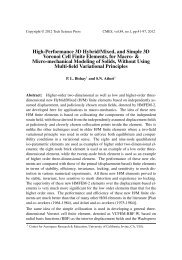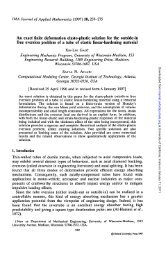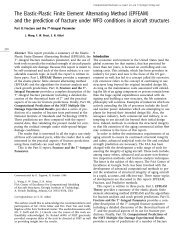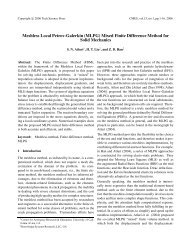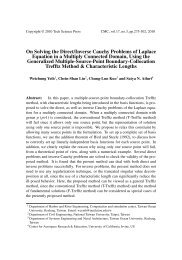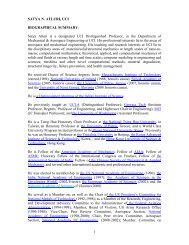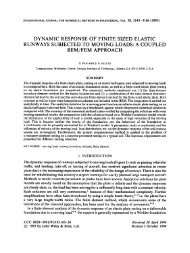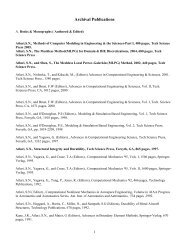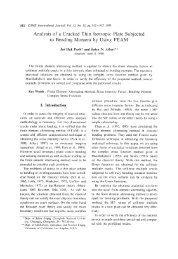on the hybrid stress finite element model for incremental analysis of ...
on the hybrid stress finite element model for incremental analysis of ...
on the hybrid stress finite element model for incremental analysis of ...
You also want an ePaper? Increase the reach of your titles
YUMPU automatically turns print PDFs into web optimized ePapers that Google loves.
1180 SATYANADHAM ATLURI<br />
If it is now assumed that <strong>the</strong> known initial <strong>stress</strong> state (ail*&; F”^; T”“) in C, is in equilibrium<br />
prior to <strong>the</strong> additi<strong>on</strong> <strong>of</strong> <strong>the</strong> <strong>incremental</strong> loads <strong>for</strong> step N, <strong>the</strong>n <strong>the</strong> right hand side<br />
<strong>of</strong> equati<strong>on</strong> (10) can be shown to be identically equal to zero. However, as pointed out by<br />
H<strong>of</strong>meister et al. [17), due to <strong>the</strong> numerical <strong>incremental</strong> soluti<strong>on</strong> technique <strong>for</strong> soiving a<br />
targe strain problem, <strong>the</strong> initial <strong>stress</strong> state in C, may not be in equilibrium. Following<br />
H<strong>of</strong>meister et al. [17], it is shown iater that it is possible to derive an equilibrium error<br />
check if <strong>the</strong> right hand side terms in equati<strong>on</strong> (10) are retained.<br />
Assuming that <strong>the</strong> elastic <strong>stress</strong>-strain relati<strong>on</strong>s are <strong>of</strong> <strong>the</strong> type<br />
or<br />
Acri” = A~*(&“@, Ae,,)<br />
Ae,, = Aelp(5*“11, da”“)<br />
<strong>on</strong>e can define an elastic strain energy functi<strong>on</strong><br />
dA = Adp dAei,.<br />
Using equati<strong>on</strong> (12) equati<strong>on</strong> (10) may be written as,<br />
6 [A(&‘@, Au~)++o*~~Au,,~AuI; -fl”Au,] dV-<br />
=<br />
s<br />
V<br />
s s1<br />
( - &“SAu~,, + F”‘6AuJ dV+<br />
I<br />
i=+Au, dS.<br />
It must be <strong>stress</strong>ed again that <strong>the</strong> right hand side in equati<strong>on</strong> (13) is a correcti<strong>on</strong> term to<br />
“check” that <strong>the</strong> initiai <strong>stress</strong>es in C, satisfy <strong>the</strong> equilibrium equati<strong>on</strong>s and boundary<br />
c<strong>on</strong>diti<strong>on</strong>s. Thus, <strong>the</strong>oretically, if <strong>the</strong> reference state CN is <strong>on</strong>e <strong>of</strong> equilibrium, in which<br />
case <strong>the</strong> right hand side <strong>of</strong> equati<strong>on</strong> (13) vanishes, <strong>the</strong> equati<strong>on</strong> (13) can be shown to yield<br />
<strong>the</strong> equilibrium equati<strong>on</strong>s, <strong>for</strong> <strong>the</strong> Piola-Kirch<strong>of</strong>f <strong>incremental</strong> <strong>stress</strong>es (due to nth loading<br />
increment) referred to <strong>the</strong> current known reference state C,, as follows:<br />
and<br />
SI<br />
ill)<br />
(lla)<br />
(12)<br />
(13)<br />
A5;; + [(aoVC + A5”“)Au;~],, + ti” = 0 (141<br />
AT” = A5%, +(&‘vp + A5yfi)Au$nV <strong>on</strong> S, . (151<br />
The principle <strong>of</strong> virtual work as given by equati<strong>on</strong> (13) can now be generalized through<br />
<strong>the</strong> usual methods, into a counterpart <strong>of</strong> Hu-Washizu variati<strong>on</strong>al principle in linear<br />
elasticity [21]. That is, we add to <strong>the</strong> functi<strong>on</strong>al in equati<strong>on</strong> (13) <strong>the</strong> c<strong>on</strong>straint c<strong>on</strong>diti<strong>on</strong>s<br />
and<br />
Ae,, = ~(Au~,~ + Au,,, + Aul;Au,,,) (16)<br />
Au, = AE,<br />
<strong>on</strong> S,.<br />
Then c<strong>on</strong>sidering <strong>the</strong> Lagrangian multipliers corresp<strong>on</strong>ding to c<strong>on</strong>straint c<strong>on</strong>diti<strong>on</strong>s (16<br />
and 16a) as do”’ and AT”, respectively, we can <strong>for</strong>mulate <strong>the</strong> generalized functi<strong>on</strong>al,<br />
% = n,(Aeh,, ; AU, ; Ad” i ATA) (17)




